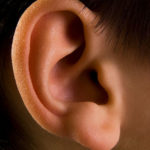Learning fiddle starts with the ears. This might be a bit of a mind-bender for some to consider, but really, it’s the ears that teach the hands. The brain won’t admit this, but its job is really to observe and take notes for next time; it doesn’t actually know enough to tell everybody what to do (shhh, don’t tell it). Of course, that doesn’t stop the brain from trying to give orders and get in the way. The eyes, meanwhile, do their best to look super important, but there’s not much they can do when it comes to playing fiddle — music is about sound, and playing the fiddle is about muscles; the eyes can’t even see what’s going on, being farther apart than the strings, and at a weird angle. This is a big comedown for the eyes, who are totally dominant  when it comes to driving, reading, using a computer, and generally helping us navigate through every day. For more on this perspective, read the blog about “Reversing Old Presumptions“.
when it comes to driving, reading, using a computer, and generally helping us navigate through every day. For more on this perspective, read the blog about “Reversing Old Presumptions“.
But here’s the rub — we think about things that we verbalize. We have a hard time thinking about the work of the ears and hands because we hardly have any words for what they do. What learners think most about, and therefore work hardest at, are concrete tasks, usually ones that their eyes and brains can direct — for example, the notes on the page, music theory about names of notes, keys, marked bowings. We imagine that our brain sits at its desk and orders the fingers to play this note and that one, and commands the bow to move so we can hear the notes.
This is all very unfair to the real workers — the ears and hands. When you make a mistake, don’t get mad at your brain for screwing up. Thank your ears for knowing what the music should sound like and alerting you that they want to hear something different than what you played. Even a total beginner’s ears can learn a group of four notes after hearing them twice, even if the beginner can’t quite play them yet.
It occurred to me that if we spotlight some useful words about the ears and muscles, we could use them to better direct our thoughts.
Let’s start with the words “ear map.” When you listen to a tune you’re learning to play, your ears map out the tune. Since in order to read this article, you have to use eyes, let’s use a visual analogy. Here is how the ears might “map” a tune to get a handle on it:
We hear the important notes in the context of the beat they land on. We feel the pulse and how it matches with the beat notes. The pathway getting us from one beat note to the next is at first a blurry one; we don’t yet know the details. We want to know where we’re headed first, then we’ll learn how to get there. In fact, if you play those beat notes on time, even if the notes in between only approximate the ups and downs of tune, you will be playing that particular tune and no other. But if you change the notes that land on the beats, you’ll be playing a different tune. Changing only the in-between notes, the pathways from one beat note to another, comes across as improv!
Next time you want to learn a tune, see if you can think about mapping it out with your ears. Rather than analyzing the map, try to recognize and anticipate the beat notes. Feel them with your body by moving, tapping, marching, or walking as you listen. Remember, music without timing is just sound.
Occupy your mind with bigger things than the notes you might see on a page — sense the phrases, just as you would hear complete sentences when someone’s speaking to you. Notice the order of phrases and when they repeat — many tunes are structured as Question & Answer, then Same Question & Better Answer. Note how you feel about the high and low points, where you sense simplicity and where complication, where the music seems comfortable and predictable, and where it surprises.
Demand more of your ears and hold them accountable as you work on a tune. Rather than play through all the notes as if checking them off a list, ask yourself some questions related to how well you listen — Did you allow your ears enough time to map the music? Are your ears hearing all the beat notes? Are they comfortable with the timing? Did you let your ears sense the profile of the music, the ups and downs, even if some of the specific notes are fuzzy? Those humble little holes in the sides of your head are doing a lot of work. They will reward you well for paying attention to them!
In the next article we’ll talk about how to clarify your ear maps, and then come up with some words to help think about what the muscles do as you play. In the mean time, listen anew to your tunes. Profile how the music travels as it rises and falls on its journey from beat to beat. Give yourself a frequent break from the quantifiable — the written notes, the finger numbers, note letters and rules — and let your ears be your guide. If you allow your brain to take a break from being in charge, it will observe, take notes, and may well notice some pleasant surprises!
©2018 Ed Pearlman
